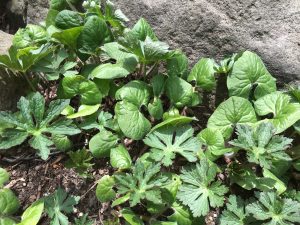Finding easy, attractive solutions for planting in shady areas
August 18, 2016
Wild ginger is a native groundcover that is ornamental while being resistant to deer. (Photo courtesy University of Illinois Extension)
“How do I grow grass under a tree?” This question seems to consistently echo through Master Gardener help desks.
This year, stop wasting time and money attempting to get grass to grow under your shade tree and try growing an ornamental ground cover instead.
“It can be very difficult to create a nice-looking stand because most grasses need sun to grow and the roots of trees (especially if they are shallow) will steal water and nutrients,” says University of Illinois Extension Horticulture Educator Kelly Allsup.
“The solution can be to create a mulch ring around the base of the tree or to grow a ground cover. Growing a ground cover can be quite beneficial, as you don’t have to mow and it can be virtually maintenance-free.”
With that said, the first year of establishment will require some maintenance by adding compost to soil, watering regularly and adding mulch to prevent weeds. In addition, the ground cover will eventually spread into the lawn if a barrier is not added.
Kelly offers five different solutions for filling the shady space under trees, broken into two categories: dry shade and wet shade.
Dry shade
Lamium has silver variegated leaves with showy purple, pink or white flowers that bloom from May to July.
It grows six to nine inches tall and has a two to three foot spread. When planting, it is best to space them 18 to 24 inches apart. This plant is also resistant to deer munching.
Pachysandra is an evergreen with whorled, glossy leaves that blooms white in April. This plant grows 6 to 12 inches high. Plants tend to spread 12 inches, so be sure to leave plenty of space between plants.
This plant will need to be thinned once it becomes well established to prevent disease. It is resistant to rabbits and deer.
Epimedium has compound heart-shaped leaves on wiry stems that turn red in the fall. It boasts attractive flowers of red or yellow in May. It grows 12 to 14 inches tall and spreads about 18 inches. Epimedium can be slow growing but is resistant to rabbits and deer.
Wet shade
Wild ginger is a native ground cover with a kidney-shaped leaf that blooms in April at the base of the plant.
Looking closely, you will also find a purple cup-shaped flower that is usually covered by the foliage. It grows 6 to 12 inches tall and spreads 12 to 18 inches. Wild ginger is also resistant to deer.
Sweet Woodruff has a delicate leaf but is a mat-forming groundcover that blooms white in late spring. It grows 8 to 12 inches tall and spreads 12 to 18 inches. It has fragrant flowers and foliage that smell like fresh-cut hay when crushed. It can be planted under black walnut trees.
For more information on ground covers, visit University of Illinois Extension’s “From the Ground Up” page at http://extension.illinois.edu/groundcovers/index.cfm or contact your local Extension office.
— Finding easy, attractive solutions for planting in shady areas —







